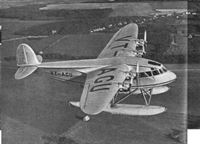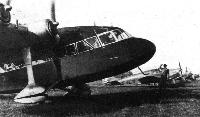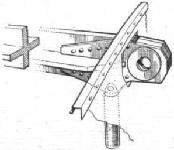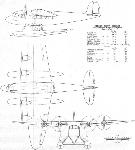
Варианты
- Short - Scion / S.16 - 1933 - Великобритания
- Short - Scion Senior / S.22 - 1935 - Великобритания
Short S.16 Scion и S.22 Scion Senior
<...>
В то время как Scion уже находился в серийном производстве, "Short Brothers" построила шесть самолетов другой модификации - S.22 Scion Senior. Они могли перевозить десять пассажиров и были оснащены четырьмя двигателями Pobjoy Niagara III мощностью 90 л. с. Один самолет использовался компанией в качестве демонстратора для продвижения сухопутного варианта. Последний из поплавковых гидросамолетов был приобретен министерством авиации для испытаний вариантов конструкции корпусов летающих лодок. Так, например, поплавки изготавливались как масштабно уменьшенные варианты корпуса лодки Sunderland.
Описание:
- Short S.16 Scion и S.22 Scion Senior
- Flight, October 1935
THE SHORT SCION SENIOR
Фотографии
-
Flight 1939-04 / Flight
Регистрационный номер: VT-AGU [11] SHORT BROTHERS' LATEST: The Scion Senior carries up to ten passengers at a maximum speed of 134 m.p.h. although its four Pobjoy Niagara engines develop a total of only 360 b.h.p. The next machine to be built will have a wheel undercarriage.
-
Flight 1936-11 / Flight
Регистрационный номер: VT-AGU [11] OUTSTANDING CIVIL TYPE: This small commercial type, the Short Scion Senior with 90 h.p. Pobjoy Niagara engines, was produced in 1935. It has seating accommodation for ten passengers.
-
Aeroplane Monthly 1989-06 / J.Stroud - Wings of Peace
Регистрационный номер: VT-AGU [11] Short Scion Senior VT-AGU over the Medway.
-
Flight 1937-11 / Flight
Регистрационный номер: VT-AGU [11] With four Pobjoy Niagara engines of 90 h.p. each the Short Scion Senior carries up to ten passengers. The machine is available both as a landplane and as a seaplane.
-
Aeroplane Monthly 1989-06 / J.Stroud - Wings of Peace
Регистрационный номер: VT-AGU [11] VT-AGU, the first Scion Senior, on the Medway. This picture shows how the fuselage protruded well forward of the floats.
-
Мировая Авиация 234
Регистрационный номер: VT-AGU [11] Первый Scion Senior был отправлен в Рангун (Бирма, ныне Мьянма) в начале 1936 года и вошел в состав компании "Irrawaddy Flotilla Company". Самолеты имели индийскую регистрацию.
-
Flight 1935-10 / Flight
Регистрационный номер: VT-AGU [11] The Short Scion Senior at her moorings in the Medway, off the works of Short Brothers.
-
Flight 1937-01 / Flight
Регистрационный номер: VT-AGU [11] The seaplane version of the unique Short Scion Senior has a maximum speed of 135 m.p.h.
-
Aeroplane Monthly 1977-12 / G.Todd - Wings over the Irrawady
Регистрационный номер: VT-AGU [11] Scion Senior VT-AGU on the Medway shortly before delivery to l.F.&A in Burma. Note the absence of the ventral fin, which was added at a later date.
-
Flight 1935-10 / Flight
Регистрационный номер: VT-AGU [11] -
Aeroplane Monthly 1977-12 / G.Todd - Wings over the Irrawady
Регистрационный номер: VT-AHI [8] VT-AHI on the slipway at Pazundaung. Much of the Rhodoia and Cellon transparent plastic glazing had to be replaced annually because of shrinkage.
-
Jane's All the World Aircraft 1938 / 01 - The progress of the world in civil aviation during the year 1937-38
Регистрационный номер: VT-AHI [8] ON THE IRRAWADDY. - A Short "Scion Senior" (four Pobjoys) of the Irrawaddy Flotilla and Airways Ltd. on its slipway.
-
Aeroplane Monthly 1977-12 / G.Todd - Wings over the Irrawady
Регистрационный номер: VT-AHI [8] A motley assortment of river craft often caused pilots much anxiety. Note the addition of the ventral fin to VT-AHI.
-
Aeroplane Monthly 1977-12 / G.Todd - Wings over the Irrawady
The same aircraft disembarks passengers at the Pazundaung slipway. Not one of the six Scion Seniors built ever hurt a soul, although they had very varied and sometimes dramatic lives.
-
Aeroplane Monthly 1977-12 / G.Todd - Wings over the Irrawady
Регистрационный номер: VT-AHI [8] VT-AHI on the crowded apron of Short's boatyard by the Medway, shortly before disassembly for packing and export in September 1936.
-
Aeroplane Monthly 1977-12 / G.Todd - Wings over the Irrawady
Регистрационный номер: VT-AHI [8] VT-AHI takes off for its first flight in Burma on October 21, 1936, in the hands of Capt Esmonde. The name Karaweik was Burmese for “a ship of state.”
-
Aeroplane Monthly 1977-12 / G.Todd - Wings over the Irrawady
Регистрационный номер: VT-AHI [8] Eyed askance by a passing boatman, VT-AHI disembarks passengers at the Pazundaung slipway. Only minutes before, this sampanwallah had fled for his life as the great machine, after thundering about his ears, hurtled down to alight in the midst of the other, equally irate, men of the river.
-
Aeroplane Monthly 1977-12 / G.Todd - Wings over the Irrawady
Регистрационный номер: VT-AHI [8] Karaweik begins the long haul up the slipway to the not unmusical chant of four good men and true toiling away at the hangar winch.
-
Aeroplane Monthly 1977-12 / G.Todd - Wings over the Irrawady
Регистрационный номер: VT-AHI [8] A hundred hands made light work of transporting Scion components to the assembly point in I.F.&A’s hangar at Pazundaung, Rangoon, on October 8, 1936.
-
Aeroplane Monthly 1977-12 / G.Todd - Wings over the Irrawady
Регистрационный номер: VT-AIJ Fitting the wings to Scion Senior VT-AIJ in February 1937.
-
Flight 1935-10 / Flight
FOR THE IRRAWADDY FLOTILLA COMPANY: The first of the new Short Scion Seniors (four Pobjoy Niagaras) on the slipway at Rochester. The machine bears Australian registration letters.
-
Flight 1935-10 / Flight
Clean aerodynamic design endows the Short Scion Senior with a good performance in spite of the relatively low power (four Pobjoy Niagara engines of 90 h.p. each). The top centre photograph on this page affords an interesting comparison between ancient and modern transport on the Medway, at Rochester.
-
Aeroplane Monthly 1989-06 / J.Stroud - Wings of Peace
One of the Irrawaddy Flotilla and Airways Scion Seniors on the Medway.
-
Aviation Historian 8 / F.Merriam - "Better to be Born Lucky than Rich..." /Echoes from Dawn Skies/ (3)
Регистрационный номер: VT-AGU [11] The shapely nose of the first Short Scion Senior. This machine has been sold to the Irrawaddy Flotilla Company for work in the east. Standing on one of the floats is Mr. J. Lankester Parker, Short's chief test pilot.
A splendid photograph of John Lankester Parker standing on the port float of the first Short Scion Senior, VT-AGU, moored in the Medway before its delivery to the Irrawaddy Flotilla Co in Rangoon in January 1936. Lankester Parker flew every Short prototype on its maiden flight until his retirement from test flying in 1945. -
Aeroplane Monthly 1977-12 / G.Todd - Wings over the Irrawady
Capt E. Esmonde poses for the camera at the conclusion of his test flight to check unuseable fuel carried by Karaweik.
-
Aeroplane Monthly 1989-06 / J.Stroud - Wings of Peace
Регистрационный номер: G-AENX Scion Senior G-AENX in the livery of West of Scotland Air Services. In February 1938 it went to Elders Colonial Airways in West Africa, and operated on coastal routes until sinking at Bathurst in the Gambia in August 1939.
-
Aeroplane Monthly 1977-12 / G.Todd - Wings over the Irrawady
Регистрационный номер: G-AECU [6], HK868 [6] The sole Scion Senior landplane, G-AECU, on charter to the Iraq Petroleum Transport company in early 1939, taxies out prior to take-off from Sharjah, Trucial Oman.
-
Flight 1937-09 / Flight
Регистрационный номер: G-AECU [6], HK868 [6] The Short Scion Senior (four Pobjoy Niagaras) is shown as a landplane.
-
Aeroplane Monthly 1988-05 / Personal album. Civil
Регистрационный номер: G-AECU [6], HK868 [6] The Short S.22 Scion Senior landplane G-AECU was a four-engined version of the Short Scion twin. It was powered by four 90 h.p. Pobjoy Niagara III radial engines and was built at Rochester in 1936.
-
Aeroplane Monthly 1989-06 / J.Stroud - Wings of Peace
Регистрационный номер: G-AECU [6], HK868 [6] G-AECU, the third Scion Senior, undertook some work for Jersey Airways before going to the Middle East. Impressed for RAF service as HK868 in 1942, it was reported lost in September 1943.
-
Flight 1937-09 / Flight
A Triton among the minnows: Piper's Short Scion Senior ready to leave the line on Friday. The next machine is Brig.-Gen. Lewin's Miles Whitney Straight, which finished second.
Другие самолёты на фотографии: Miles Whitney Straight / M.11 - Великобритания - 1936
-
Air-Britain Archive 1980-02
Регистрационный номер: G-AECU [6], HK868 [6] Four Pobjoy engines powered the Scion Senior which, like the Scion, was fitted with wheels or floats.
The new Short Scion Senior with four Pobjoy Niagara engines appeared at Hatfield for the first time as a landplane.
Short S.22 Scion Senior G-AECU featured in the Applications on 2.3.36 and first flew on 15.6.36 as the first landplane version as indicated by the Type Modification annotation. It ended its days while impressed as HK868 on a flight from Heliopolis on 22.9.43 from which it never returned. -
Flight 1937-09 / Flight Advertisements
Регистрационный номер: G-AECU [6], HK868 [6] SHORT SCION SENIOR. 8-10 SEATER LAND OR SEAPLANE. 4 POBJOY NIAGARA ENGINES. CRUISING SPEED 127 M.P.H.
-
Flight 1936-09 / Flight
During the demonstrations: The Short Scion Senior over a section of the crowd
-
Flight 1937-09 / Flight
Mr. Piper in the Short Scion Senior entertains the Wilmington crowd.
-
Flight 1936-07 / Flight
The hinged nose of the fuselage permits inspection of the flying controls, instruments and other equipment, and attracted a good deal of attention.
-
Aeroplane Monthly 1989-06 / J.Stroud - Wings of Peace
The cabin of a Scion Senior.
-
Flight 1936-07 / Flight
Short Scion Senior. Showing the seating accomodation. The lavatory is amidships
-
Flight 1936-07 / Flight
Short Scion Senior. The well streamlined undercarriage
-
Flight 1936-07 / Flight
Short Scion Senior. The power plant installation (Pobjoy Niagaras)
-
Flight 1935-10 / Flight
Details of the wing construction: The spar is in the form of a girder "box," in which the corner flanges are of extruded cruciform section and the bracing members are tubular.
-
Flight 1935-10 / Flight
One of the joints which secure the outer wings to the centre-section.
-
Flight 1935-10 / Flight
The grouping, in the stern, of the elevator and rudder control leads is shown in the upper drawing. The sprockets and small pulleys are for the rudder and elevator "tab" controls. The lower diagram shows how these control leads are arranged.
-
Flight 1935-10 / Flight
Short Scion Senior Four Pobjoy Niagara Engines
- Фотографии











































